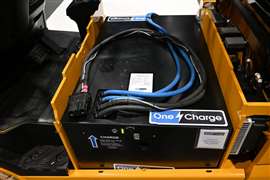Read this article in Français Deutsch Italiano Português Español
Global Battery Alliance executive director on battery passports and a sustainable battery value chain
25 April 2024
The organization included battery passports in its 2030 vision report. Executive Director Inga Petersen talked to Power Progress about how battery passports can contribute to a sustainable battery value chain.
In January, Power Progress reported on digital battery passports, which are electronic records containing complete information about a rechargeable battery and its provenance. They are a requirement of European Union (EU) Regulation 2023/1542, which addresses the battery supply chain within the EU. Under the regulation, battery passports will be required for many rechargeable batteries, including those used in battery electric vehicles (BEV) beginning in February 2027.
The Global Battery Alliance (GBA), a multi-stakeholder public/private alliance based in Belgium with more than 160 members representing the full battery value chain, issued a report in 2019 on its vision for establishing a sustainable, circular battery value chain by 2030. That vision report included the idea of battery passports and was referenced in the preamble to the EU battery supply chain regulation.
Inga Petersen, GBA executive director, said the rapid proliferation of BEVs around the world makes battery passports an important component in ensuring sustainability across the battery supply chain.
“The Global Battery Alliance came into being with the twin realizations that batteries are going to play an essential role for the green transition in terms of meeting Paris Agreement targets through electrification of transport and power sectors,” she said, “and that there are also sustainability risks and impacts along the supply chain that are likely to be enhanced through this rapid scaling of the industry and that need to be carefully managed in order to scale the industry fast enough but also in a sustainable way.”
Value Chain Sustainability
Petersen said the battery passport seeks to achieve transparency digitally across what is typically an opaque battery value chain. It also seeks to integrate key sustainability and performance expectations as well as provide harmonized reporting against those expectations. The challenge, according to Petersen, is in defining what sustainability means across the battery value chain.
“We have a long list of about 25 risks and impacts along the value chain,” she said. “We’re currently convening multi-stakeholder working groups to define for each of these issues what the mechanisms or the tools are that a company can deploy, including existing responsible sourcing standards, — what efforts they can make to address these risks and impacts.”
Petersen added these working groups will also address making those mechanisms scorable and comparable at the product level so that procurement departments and customers can consider sustainability performance in making purchasing decisions. She added the long-term goal is to establish a scoring and rating system for benchmarking batteries with an eye for creating a GBA quality seal “to give this easy-to-understand mark of quality when it comes to sustainability performance.”
As part of this effort, GBA has already established a greenhouse gas rulebook, the goal of which, Petersen said, is to “have a harmonized methodology to establish the battery carbon footprint so that you can actually compare separate products with each other as opposed to having quite broad standards.”
Supporting Brand Reputation
For OEMs and battery makers alike, the battery passport should have a positive impact on brand reputation, Petersen said.
“The GBA Battery Passport will provide a framework to independently validate companies’ due diligence efforts, including but going beyond regulatory compliance to voluntary disclosures.”
As an example, she said the GBA is currently working on due diligence requirements and best practices regarding forced labor, indigenous peoples’ rights, biodiversity and circular design. By documenting relevant data in the battery passport, a company can demonstrate the compliance of its products with regulations addressing these topics.
For companies looking into sustainability risks and impacts related to batteries, battery passports also address issues of circular economy, resource efficiency and product safety and quality.
“If you combine all of those elements with sustainability, I think there are some clear business and economic incentives to have that type of transparency over the products and the materials that you’re procuring,” Petersen said.
The transparency inherent in battery passports aligns with an organization’s environmental, social and governance (ESG) reporting needs, which are particularly important when attracting funding from sustainability-minded investors.
“We’re having a tremendous level of interest from the investor community,” Petersen said, “who are looking for this type of rating scheme for these products so that they can also ensure that they’re de-risking their portfolio or even streamlining requirements for responsibly sourced products.”
Global Consideration
While at present the EU is the only region to tie legislation to battery passports, they are being considered in other regions of the world.
“We definitely see this in China, where a limited version of the battery passport has already been in operation for years, but more around tracing products during the in-use phase and ensuring that you have material recovery for recycling,” Petersen said. “Because if you’re looking at electrification of passenger vehicles, China is probably a good decade ahead of Europe and the rest of the world.”
According to Petersen, it is likely there will broader efforts to mainstream battery passports in China, including battery carbon footprint declarations.
In the U.S., GBA has engaged with various stakeholders regarding battery passports over the years, she said, although interest had not been high due to concerns about implementation. However, that has changed recently, primarily due to a couple of significant developments.
“One is the EU battery regulation, which is likely to also affect U.S. car manufacturers who want to export into the EU market,” Petersen said. “The other one is the Inflation Reduction Act (IRA) and the provenance requirements on the materials. And how do you demonstrate that outside of a battery passport-type structure, even if you limit it just to the traceability information? So, we absolutely see this emerging in the U.S.”
She added that extensive mandatory regulatory requirements about sustainability metrics beyond traceability of materials are less likely in the U.S. in the near term, “but once you have this traceability in place, it’s not a very long stretch to actually add sustainability reporting onto it — maybe in a voluntary fashion to begin with.”
While the adoption of battery passports in the EU appears to be setting a trend that will extend to other products and regions, Petersen said GBA hopes there will not be battery passports specific to global regions — one for the EU, one for China, one for the U.S., etc. GBA sees that approach as untenable for companies and their reporting requirements.
“We’re really focusing our efforts on creating these globally harmonized performance expectations that, whether you are producing in China or in the U.S. or in Korea, should be equally applicable.”
Equipment OEM Participation
Equipment OEMs are just beginning to participate in the GBA, Petersen said.
“Komatsu recently joined us, probably as one of the first of the segment. It’s probably a logical evolution for them [OEMs] to also try and understand, because when it comes to battery size and capacity, they’re most likely to need that. And if you are least looking at the EU, where [the regulation] is above 2 GW per hour, that is more often than not the case for the OEMs in your readership.”
According to Petersen, now is the time for OEMs to engage with GBA, “to better understand upcoming battery passport requirements and contribute to efforts to develop globally harmonized frameworks for sustainability performance expectations for batteries.”
POWER SOURCING GUIDE
The trusted reference and buyer’s guide for 83 years
The original “desktop search engine,” guiding nearly 10,000 users in more than 90 countries it is the primary reference for specifications and details on all the components that go into engine systems.
Visit Now
STAY CONNECTED




Receive the information you need when you need it through our world-leading magazines, newsletters and daily briefings.
CONNECT WITH THE TEAM
















